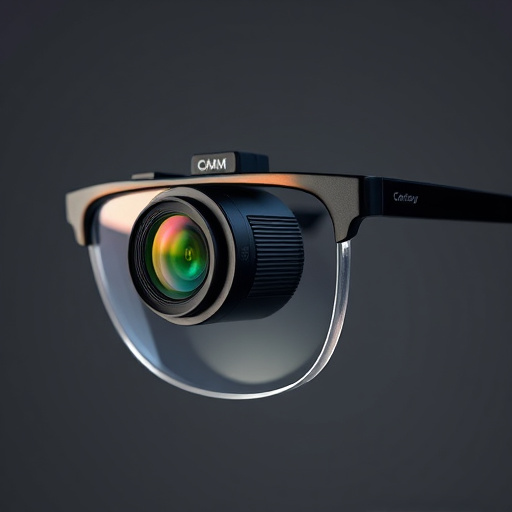Glasses with integrated cameras, or smart glasses, are transforming visual capture by combining photography and videography into wearable optics. Offering unparalleled convenience, these glasses allow users to easily snap photos and record videos without hands-free operation. From travel vlogging to professional applications like remote inspections, they're poised to revolutionize various sectors. With compact designs, Bluetooth/Wi-Fi connectivity, and diverse features from different brands, smart glasses cater to various needs while raising privacy and ethical considerations that must be addressed.
“Discovering the future of visual storytelling, we explore the innovative world of glasses with a camera built-in. These cutting-edge devices are transforming how we capture and share moments, offering a hands-free, discreet way to record your perspective. In this comprehensive guide, we’ll unravel the technology behind these smart glasses, delve into their diverse applications, and discuss the ethical implications as we navigate this exciting new era of glasses with a camera built-in.”
Understanding Glasses with a Built-in Camera: A New Era of Visual Capture
Glasses with a camera built-in are ushering in a new era of visual capture, transforming how we perceive and document our surroundings. These innovative devices seamlessly integrate photography and videography functionality directly into wearable optics, allowing users to effortlessly snap photos and record videos with just a glance. The rise of glasses equipped with cameras signifies a significant shift in personal expression and documentation, offering unparalleled convenience and versatility.
This technology promises to revolutionize various sectors, from consumer vlogging and travel documentation to professional applications like remote inspections and augmented reality experiences. With their compact design and hands-free operation, these camera glasses provide a fresh perspective on visual storytelling, enabling users to capture moments with natural ease and share them instantly in the digital age.
How Do These Camera Glasses Work and What Are Their Key Features?
Camera glasses with a built-in lens have gained popularity as a hands-free, discreet way to capture moments and create content. These innovative devices typically consist of two tiny cameras, one in each eye piece, allowing for a 360-degree field of view. The images are then seamlessly stitched together to create a single, panoramic shot or video.
Key features often include HD video recording, photo burst capabilities, and various shooting modes. Some models even offer advanced functions like stabilization for clear footage during movement. The glasses usually connect to your smartphone via Bluetooth or Wi-Fi, enabling easy transfer of media and real-time editing options. Their compact design, lightweight build, and ease of use make them ideal for travel, sports, and everyday vlogging.
Benefits and Applications: Why You Might Want to Own a Pair
Glasses with a camera built-in, often referred to as smart glasses or camera eyewear, offer a host of benefits and applications that can enhance your daily life. One of the primary advantages is their convenience; these glasses integrate seamlessly with your smartphone, allowing you to capture moments hands-free. Whether it’s taking spontaneous photos or recording videos during your adventures, these cameras provide an immersive experience without the need for bulky equipment.
Additionally, camera glasses have diverse use cases. They are perfect for travelers, enabling them to document their journeys and share experiences instantly. For professionals in fields like architecture, engineering, or real estate, these glasses can aid in creating detailed visual reports and presentations. Moreover, their compact design makes them ideal for sports enthusiasts who want to capture action-packed scenes without compromising on performance or comfort during their activities.
Exploring Different Types and Brands on the Market
When it comes to exploring different types and brands of glasses with a camera built-in, the market offers a wide array of options catering to various needs and preferences. From sporty designs ideal for action enthusiasts to sleek and fashionable frames suited for everyday use, there’s a pair tailored to every user. Leading tech companies and eyewear manufacturers have collaborated to integrate cutting-edge imaging technology directly into these glasses, ensuring high-quality video and photo capture without the bulk of traditional cameras.
Popular brands like GoPro and DJI offer rugged, durable options perfect for outdoor adventures, while others such as Vred Steals and Ray-Ban provide stylish models that blend seamlessly with contemporary fashion. Each brand brings unique features to the table, from advanced stabilization systems to intuitive controls and high-resolution sensors. Understanding these distinctions is key to choosing the ideal glasses with a camera built-in, aligning perfectly with your desired functionality and aesthetic.
Privacy, Ethics, and Future Implications: Considerations for Wearers
With the rise in popularity of glasses with a camera built-in, several important considerations arise regarding privacy, ethics, and future implications for wearers. As these devices become more ubiquitous, they introduce new challenges around personal space and consent. Wearers must be mindful of how their actions captured by the integrated cameras could impact their own privacy as well as that of others. For instance, unintended footage or misuse of recorded content could lead to invasions of privacy, with serious consequences in today’s digital age.
Ethical dilemmas also surface when considering the potential for surveillance and data collection. Glasses with cameras could be used to monitor individuals without their explicit knowledge or consent, raising concerns about data protection and the right to privacy. As technology advances, there is a need for robust regulations and guidelines governing the use of such devices to ensure responsible innovation in the market. The future implications suggest that wearers should actively engage in understanding how these glasses work, what kind of data they collect, and who has access to it, to make informed decisions about adopting this technology.
